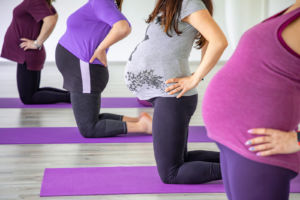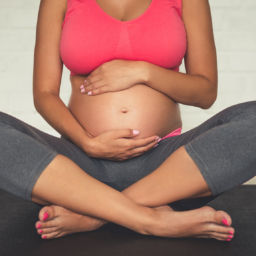Prenatal Yoga
Women who are both experienced yoginis and those who aren’t even quite sure what yoga is will benefit from yoga during pregnancy. Yoga, the ancient Hindu practice of “yolking the mind and breath”, is more than just a set of postures, but also includes a focus on breathwork and meditation. Pregnant people don’t have to become yoga masters to benefit from prenatal yoga, but many find that incorporating some yoga postures and breathwork can help ease common discomforts of pregnancy while also reducing stress.
Practiced somewhat regularly throughout each trimester (especially the second and third), the postures and breathwork may lead to better fetal positioning and therefore easier births, while both the postures and breathwork may help to ease discomfort, stress, and anxiety throughout pregnancy, labor, and delivery. Some studies have even found that yoga may reduce the risk of interventions during childbirth, and that yoga may be also be a helpful tool for women who have been labeled with high risk pregnancy.
Most yoga programs that have been studied require that a woman attend a 30 – 70 minute class two to three times per week. A typical prenatal yoga class might include an introduction to the class where a theme is introduced or women are invited to set the stage for their practice with a mantra (“I am a good mom”; “I have everything I need to birth this baby”) followed by a brief period of relaxation that helps participants to enter the present moment. This is typically followed by a series of postures that help to both strengthen and stretch while increasing awareness of the body and the breath. The class may also include some balance work and some seated stretching before ending in a deep relaxation pose called savasana (this is typically modified in prenatal classes to accommodate pregnant bellies).
Even women who haven’t formally exercised for a year before beginning a prenatal yoga program may experience positive results. Sun et al. (2010) found that women who began a prenatal yoga routine in their third trimester experienced significantly less pregnancy-related discomfort than women who did not do prenatal yoga, and they also experienced greater self-efficacy in both active labor and during the pushing phase of labor.

Pregnant women may also find that prenatal yoga helps to reduce stress levels (Pascoe & Bauer, 2015), symptoms of anxiety and depression (Battle et al., 2015; Davis et al., 2015), and it may also have positive impact on the immune system. Chen at al. (2017) measured chemical markers of stress and immune system activation in womens’ saliva. Women who were in the yoga group had significantly lower levels of the stress hormone cortisol and higher levels of salivary immunoglobulin A (IgA) than the control group immediately after yoga. In addition, the increased IgA levels were sustained over a longer time period in the yoga group. The study also found that infants born to women in the yoga intervention had higher birth weights. These results provide further evidence of the beneficial impact of yoga to reduce stress and improve birth outcomes.
A common concern for pregnant women is wondering about the pain of the childbirth experience. In a randomized control trial, Jahdi et al (2017) found that women who took part in a prenatal yoga program experienced a variety of benefits during labor including significantly reduced perception of pain at 3-4cm dilation and at 2 and 4 hours after initial measurement. These mothers were also significantly less likely to have their labors augmented and had lowered risk of cesarean section. Finally, they also had shorter durations of second and third stages of labor.
Although the majority of these studies focus on trials of low-risk women, a study by Rakhshani et al. (2012) found that benefits may also come to women who have been deemed high risk. This study compared high risk pregnant women who did yoga with women who walked for exercise through the same time period. The women who engaged in the yoga program were significantly less likely to have cases of pregnancy induced hypertension, preeclampsia, gestational diabetes, and intrauterine growth restriction. Babies were also less likely to be classified as Small for Gestational age or to be born with low APGAR scores.
Women who are interested in pursuing the benefits of yoga in their own pregnancies might consider incorporating a simple sequence into their week. An example is found in Pregnancy Childbirth and the Newborn. They recommend including the following sequence that consists of periods of exertion followed by rest as this mimics the typical labor pattern:
- Tailor-sit with eyes closed focusing on the breath and quieting the mind
- Cat pose
- Child’s pose
- Opposite-limb extensions
- Child’s pose
- Downward-facing dog pose
- Child’s pose
- Half-dog pose
- Final relaxation pose which can either be lying on the back, side-lying, or lying with legs up a wall. It is best to spend 5 – 10 minutes in this position to help integrate the poses and find rest and relaxation.
For optimal benefits, it is best to try doing this at least 2 – 3 times per week. For more comprehensive information about prenatal yoga, try books such as:
- Yoga Mama by Linda Sparrowe
- Bountiful, Beautiful, Blissful: Experience the Natural Power of Pregnancy and Birth with Kunalini Yoga and Meditation by Gurmukh
- Yoga for Pregnancy and Birth by Uma Dinsmore-Tuli
- Yoga for Pregnancy, Birth and Beyond by Francoise Barbira Freedman
- Birth Wisdom Yoga Remedies and Journal: A Complete Prenatal Guide by Julia Piazza
- Birth in Awareness: A Handbook of Prenatal Yoga by Gabrielle Earls
There are also many yoga classes offered at online yoga websites such as Yoga Glow, Gaia Yoga, and there are various DVDs. Reserach suggest that there are benefits to stress reduction using these methods as well (Kusaka et al., 2016). However, going to a class in person has the added benefit of an experienced instructor to ensure that poses are being done properly and usually this person has some experience in answering questions related to pregnancy and birth. In-person classes are also helpful to network and provide comradery with women going through a similar phase of life. Search your local area to find classes near you.
If you are reading this and are local to the Northeast Ohio area there are prenatal yoga classes available at Awaken Yoga in Mentor and Blue Sky Yoga in Willoughby.
References
Battle, C. L., Uebelacker, L. A., Magee, S. R., Sutton, K. A., & Miller, I. W. (2015). Potential for Prenatal Yoga to Serve as an Intervention to Treat Depression During Pregnancy. Womens Health Issues, 25(2), 134-141. doi:10.1016/j.whi.2014.12.003
Chen, P., Yang, L., Chou, C., Li, C., Chang, Y., & Liaw, J. (2017). Effects of prenatal yoga on women’s stress and immune function across pregnancy: A randomized controlled trial. Complementary Therapies in Medicine, 31, 109-117. doi:10.1016/j.ctim.2017.03.003
Davis, K., Goodman, S. H., Leiferman, J., Taylor, M., & Dimidjian, S. (2015). A randomized controlled trial of yoga for pregnant women with symptoms of depression and anxiety. Complementary Therapies in Clinical Practice, 21(3), 166-172. doi:10.1016/j.ctcp.2015.06.005
Jahdi, F., Sheikhan, F., Haghani, H., Sharifi, B., Ghaseminejad, A., Khodarahmian, M., & Rouhana, N. (2017). Yoga during pregnancy: The effects on labor pain and delivery outcomes (A randomized controlled trial). Complementary Therapies in Clinical Practice, 27, 1-4. doi:10.1016/j.ctcp.2016.12.002
Kusaka, M., Matsuzaki, M., Shiraishi, M., & Haruna, M. (2016). Immediate stress reduction effects of yoga during pregnancy: One group pre–post test. Women and Birth, 29(5). doi:10.1016/j.wombi.2016.04.003
Pascoe, M. C., & Bauer, I. E. (2015). A systematic review of randomised control trials on the effects of yoga on stress measures and mood. Journal of Psychiatric Research, 68, 270-282. doi:10.1016/j.jpsychires.2015.07.013
Rakhshani, A., Nagarathna, R., Mhaskar, R., Mhaskar, A., Thomas, A., & Gunasheela, S. (2012). The effects of yoga in prevention of pregnancy complications in high-risk pregnancies: A randomized controlled trial. Preventive Medicine, 55(4), 333-340. doi:10.1016/j.ypmed.2012.07.020
Simkin, P., Whalley, J., Keppler, A., Durham, J., & Bolding, A. (2018). Pregnancy, childbirth, and the newborn: The complete guide. New York, NY: Da Capo Lifelong.
Sun, Y., Hung, Y., Chang, Y., & Kuo, S. (2010). Effects of a prenatal yoga programme on the discomforts of pregnancy and maternal childbirth self-efficacy in Taiwan. Midwifery, 26(6). doi:10.1016/j.midw.2009.01.005






